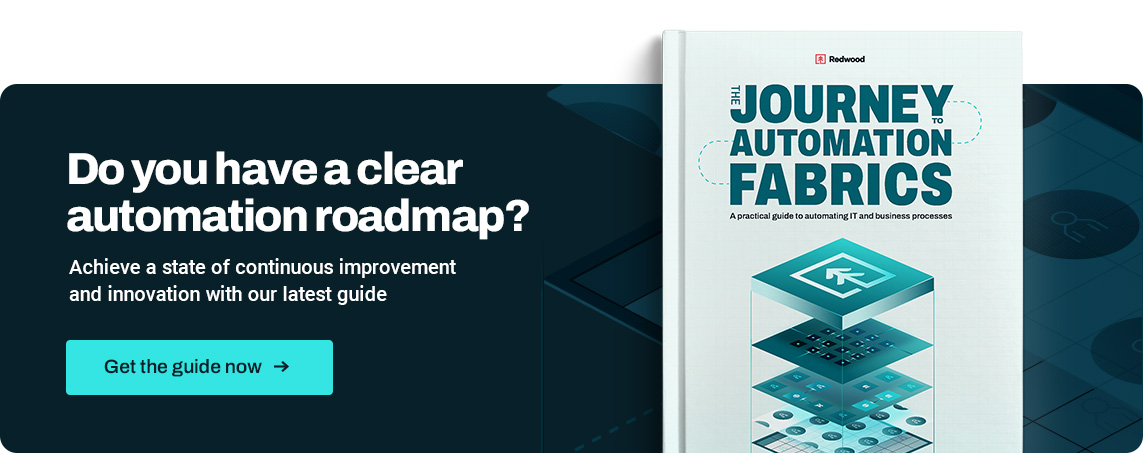5 signs it’s time to upgrade your automation strategy

Digital transformation is an imperative, but awareness of its importance isn’t enough to make it successful. 81% of IT leaders say silos are hindering their transformation efforts.
If you know you’re in this group or your organization faces other efficiency roadblocks, you can’t wait any longer to streamline with automation. But what if you’re not sure? Recognizing when it’s time to invest in modernization projects can prove challenging.
This list will help you identify the indicators that your organization is poised to boost its automation maturity level to keep pace with the demands of your industry and customer base.
1. Comparatively slow processes
If you’re relying too heavily on manual effort, you’ll notice that routine tasks are time-consuming and require constant human intervention. You may notice a difference in speed and efficiency across teams and departments or compared to peers in your industry.
For instance, in the order-to-cash process, your employees might be manually entering sales orders, which delays order fulfillment and increases error rates. Or, your procurement team may still be using spreadsheets to track purchase orders and invoices and be slow to flag issues — a sign that automation should be on your radar.
The impact: Reliance on manual processes can act as a significant barrier to progress and prevent your organization from achieving best-in-class performance. Manual tasks slow down response time and tie up valuable human resources in work that could easily be automated. The cumulative effect is reduced efficiency and a growing gap between what your organization can achieve and what it needs to achieve to stay competitive.
Next steps: Assess which manual processes and workflows are ripe for automation. The low-hanging fruit often includes repetitive tasks that require little human judgment but are prone to error. By automating these, you gift your team the time to focus on higher-value work and protect your bottom line by reducing costly mistakes.

2. Lack of integration between systems
When your software platforms operate in silos, unable to share data seamlessly, your employees spend too much time manually transferring data from one system to another or using workarounds like exporting and importing spreadsheets. Data is difficult to find and can be inaccurate. In key business processes like meter-to-cash, disjointed systems can create a big risk of inaccurate billing.
The impact: Core business metrics should drive your decisions. Inefficiencies get in the way and become a true strategic liability. Without the functionality to integrate your most critical platforms, your team may duplicate efforts. Your entire organization becomes vulnerable to inaccuracies that mislead decision-makers and slow down your progress toward key business objectives.
Next steps: Investigate the business value of a workload automation platform that integrates with all your SAP and non-SAP systems across any IT environment to encourage seamless data flow and set the stage for future process automations.
3. Difficulty scaling operations
Struggling to handle increased workload or demand fluctuations can be a sign that you need to implement automation (or better automation solutions) as soon as possible. A surge in orders or customer inquiries could overwhelm your system if your automation tools are hard-coded and inflexible. In a period of growth, you need to be prepared to adapt to new business requirements, integrate new sales channels or onboard new team members.
The impact: Inability to scale begins as an operational challenge but can balloon into missed lucrative opportunities and a declining customer experience. Insufficient or absent automations both contribute to stagnation across all areas of your business.
Next steps:
- Evaluate low-code/no-code automation tools that democratize automation design and provide easy opportunities to extend the power of your growing IT team and free them up for innovation.
- Leverage AI in areas where it matters most, such as for SLA performance.
4. High operational costs with limited ROI
Rising costs and zero or negative return on investment (ROI) point to problems with your automation strategy. You might experience this unfortunate combination if you’re using legacy systems or outdated automation tools that don’t speak to each other. Licensing fees, maintenance costs and the IT resources required to develop and monitor automations across a complex environment can result in persistent budget overruns.
The impact: High operational costs create everyday challenges, such as difficulty pinpointing the right pricing strategy. But they’re also a silent killer of innovation because they create an urgency to constantly address inefficiencies. There’s no room for investing in new technology when you’re frustrated with your current stack.
Next steps: Perform a cost-benefit analysis of your existing automation tech stack and compare it to the potential cost savings of transitioning to an automation fabric solution.
5. Frequent compliance or security issues
An inability to maintain compliance or prevent and respond to security breaches is a red flag that your current processes are outdated or insufficiently automated. Difficulties maintaining accurate records for tax compliance, for example, can mean your monitoring and reporting aren’t where they need to be. If project managers, finance teams and other stakeholders don’t know what’s happening with critical jobs across all business units, proving you’re sticking to regulations in the event of an audit won’t be possible.
Similarly, a security breach requires an immediate response, which humans can’t always provide. Nor can they engage in the level of testing efforts that automated tools can. Continuing to rely on manual testing and quality assurance can leave your organization vulnerable.
The impact: Compliance and security are vital to your business’s existence, not just its success. Failure in these areas can result in fines or operational disruptions, but more significantly, it can damage your reputation irreparably. With both your customers and regulators, trust is everything. The risks of non-compliance are far higher than the costs of migrating to an end-to-end automation solution you can count on.
Next steps: Implement automated compliance and security monitoring with a centralized workload automation solution to ensure consistent adherence to regulations.
Mature your automation strategy now
Recognizing these signs is the first step in transforming your organization’s approach to the automation process. But failing to act on that awareness can increase your risk of being left behind — in your industry and in business in general.
Automation is not just where technology is going. It’s already here. The question is: Are you willing to do what it takes to make real change, so you don’t get trapped in a stalled automation project or tied to automation tools that aren’t capable of taking you where you want to go?
Luckily, a push for prioritizing automation can pair wonderfully with other technology transformations. If you’re transitioning to SAP S/4HANA Cloud, for example, you don’t have to wait until that move is over to begin building automation technology like Redwood Software’s suite of automation fabric solutions into your plans and actionable steps.
It is important, however, to know exactly where you stand before getting started.
Identify your organization’s level of automation maturity and get personalized recommendations with our new, convenient assessment.
About The Author

Charles Caldwell
Charles is an excellence-driven product and customer success leader with over 20 years of experience building technical teams, delivering commercial products and customer retention and supporting complex B2B sales to mission-critical commercial and corporate software applications. Prior to joining Redwood, Charles was the VP of Product Management at Logi Analytics.
Charles also has experience ensuring customer success. He created the Customer Success Organization at Logi, which helped transform how support was delivered to its customers.
Charles holds a Master of Business Administration, with a concentration in Small Business, Entrepreneurship & Decision Sciences from George Washington University in Washington, D.C. He also holds a Bachelor of Science in Maritime Transportation from Massachusetts Maritime Academy in Bourne, Massachusetts.